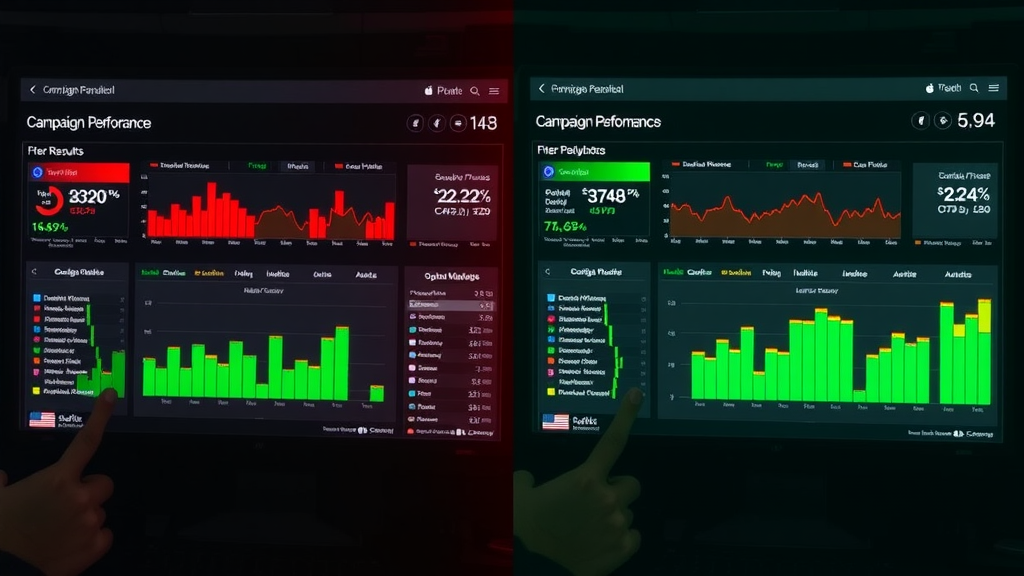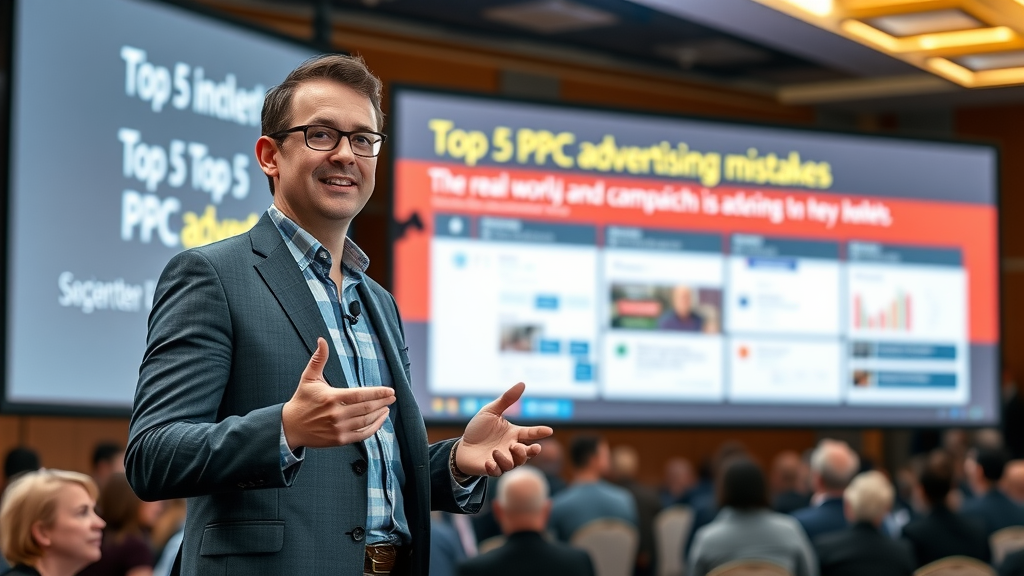Did you know nearly 61% of pay-per-click advertising budgets are wasted on avoidable mistakes? If you're investing in PPC ads, that should stop you in your tracks. Pay-per-click advertising is one of the fastest ways to drive traffic and leads—but one wrong move and your ROI can evaporate overnight. Whether you’re a seasoned digital marketer or a business owner running your own ad campaigns, dodging these PPC pitfalls is critical. In this guide, we’ll walk you through the most expensive pay-per-click advertising errors, and give you the actionable fixes you need to reclaim every dollar.

How Pay-Per-Click Advertising Errors Can Drain Your Budget
- Did you know that nearly 61% of pay-per-click advertising budgets are wasted due to avoidable mistakes? Discover where money leaks from your PPC campaigns and how to stop it.
Maximizing your pay-per-click advertising budget is about more than setting daily spend limits—it’s about spotting silent killers in your PPC campaign strategy. Errors like poor keyword targeting, ignoring negative keywords, or neglecting landing page alignment can covertly siphon away your profits. Every click you pay for but fail to convert means your competitors are one step ahead. Many businesses rely on Google Ads or social media PPC ads to quickly reach potential customers, but without understanding where mistakes happen and how to fix them, you’re likely to see a negative return on ad spend.
Avoiding these budget-draining blunders requires vigilance at every stage: from campaign setup, creating focused ad groups, writing relevant ad copy, to consistently optimizing your cost per click (CPC) and conversion rate. By identifying where your PPC campaigns lose money, you can reallocate your ad spend more judiciously, ensuring each dollar generates measurable results.
The Real Cost of Pay-Per-Click Advertising: Maximize Every Dollar
Every cent invested in pay-per-click advertising should deliver a real return—otherwise, you're just funding the ad platforms. Understanding the true cost per click goes beyond the number in your Google Ads dashboard; it means calculating the actual value you receive from each click in terms of new leads, sales, or brand exposure. Costs vary dramatically by industry, target audience, and keyword competitiveness, making it crucial to know where your investment stands relative to industry benchmarks.
Let’s be clear: not all clicks are created equal. Fixating on low-cost clicks can lead you to irrelevant traffic and wasted ad spend, while overly expensive keywords might never pay off unless you have a high-value offer and optimized conversion funnel. The key is finding the optimal balance—paying enough for the right traffic, not just any traffic, and continuously refining your ppc ads and landing pages. Smart advertisers use robust tracking to ensure every click serves the campaign’s bottom line.
Understanding Cost Per Click and Why It Matters in Pay-Per-Click Advertising
Cost per click (CPC) is the amount an advertiser pays each time someone clicks their PPC ad. It’s the linchpin metric for every pay-per-click advertising strategy, directly influencing your total ad spend, ROI, and scalability. A lower CPC means you can acquire more traffic within your budget, but it’s critical to maintain quality — cheap clicks that don’t convert are still wasted money.
Effective management of cost per click involves strategic bidding, precise keyword targeting, and ongoing optimization of ad relevance and landing page quality. For example, a business in the legal niche might pay over $6 per click, while an eCommerce retailer might secure targeted traffic at under $1.50 per click—yet ROI depends on how well those visitors convert.
| Industry | Avg. Cost Per Click (USD) | Industry ROI Benchmark |
|---|---|---|
| Legal | $6.75 | 150%-200% |
| Finance | $3.50 | 130%-180% |
| Retail/eCommerce | $1.25 | 300%+ |
| Real Estate | $2.15 | 180%-220% |
| Technology | $2.50 | 170% |

Common Pay-Per-Click Advertising Mistakes That Undermine PPC Campaigns
Even the most experienced advertisers fall into costly traps with PPC ad campaigns . Overspending on broad match keywords, ignoring vital negative keywords, or failing to optimize the landing page can turn a promising strategy into a money pit. These mistakes not only inflate your CPC but also lower Quality Scores, limit ad placements, and dilute your overall ad spend.
Routine errors such as poor ad group structure, irrelevant ad copy, and “set it and forget it” campaign management result in unnecessary waste. The good news: each of these blunders can be fixed with data-driven insights and deliberate action, transforming struggling PPC campaigns into profit-generating engines.
Wasting Budget on Broad Match Keywords in Pay-Per-Click Advertising
Broad match keywords sound appealing—they promise to capture a wider audience. But in reality, they often cast too wide a net, pulling in unqualified clicks that drain your budget without tangible returns. When your PPC ads appear for loosely related or irrelevant search terms, not only is your cost per click higher, but your average conversion rate plummets.
Smart digital marketers recommend starting with phrase or exact match keywords to ensure that every click comes from a genuinely interested potential customer. Continually reviewing search term reports in Google Ads lets you identify and exclude expensive, non-converting queries, tightening your campaign’s focus. A balanced keyword strategy minimizes risk and sets a foundation for profitable pay-per-click advertising .

Ignoring Negative Keywords in Google Ads and Cost Per Click Optimization
Negative keywords are the unsung heroes of cost control in pay-per-click advertising . By specifying which search queries you DON’T want your ads to show for, you immediately filter out non-buyers, job seekers, researchers, and other irrelevant traffic. Ignoring negative keywords not only bloats your ad spend but also muddies your campaign’s data, making it harder to optimize effectively.
Regularly updating your negative keyword list based on actual search terms is non-negotiable for campaign health. Businesses who make this a regular part of campaign management see lower costs per click, higher conversion rates, and much stronger ROI from their PPC ads. Think of it as putting up a solid fence around your ad spend.
Neglecting Landing Page Optimization for PPC Ad Success
A top-performing PPC campaign is only as good as the landing page it drives visitors to. If your ad promises “affordable fencing repairs,” but the landing page is generic or overloaded with irrelevant information, you’ll lose conversions—no matter how much you drop on cost per click . A disconnect between your ad group’s promise and your landing page content typically results in higher bounce rates and wasted budget.
Effective landing page optimization techniques include crafting a clear headline that matches the ad, writing concise and benefit-focused copy, and adding strong call-to-action buttons above the fold. Ensuring the landing page is mobile-responsive and loads quickly are also factors search engines consider for PPC ad quality scoring.
- Other pay-per-click advertising blunders:
- Poor tracking
- Irrelevant ad copy
- Suboptimal ad group setup
- “Set and forget” campaigns without ongoing optimization
How to Structure Your PPC Ad Groups for Maximum Pay-Per-Click Advertising Efficiency
The backbone of any high-performing ppc ad campaign is a well-organized ad group structure. Each ad group should focus on a tight cluster of highly relevant keywords, paired with tailored ad copy and the most appropriate landing page. Lumping too many unrelated keywords together confuses both search engines and potential customers, driving up costs and lowering click-through and conversion rates.
Leading google ads specialists advocate for the “SKAG” (Single Keyword Ad Group) method, where each ad group targets one primary keyword or a very tight theme. This approach allows for extremely relevant ad creative, streamlined tracking, and more precise bid adjustments, ensuring ad placements appear where they matter most.
Best Practices for Building High-Performance Ad Groups in Google Ad and Google Ads
Start by conducting thorough keyword research to create a granular list of search terms aligned with your product or service. Build targeted ad groups around similar intent or closely related phrases. For each ad group, write multiple variations of ad copy that include the targeted keywords and a clear call to action. Link each ad group to a landing page specifically optimized to match the search intent of the keywords.
Regularly analyze performance data to split underperforming ad groups or pause low-performing keywords. Leverage ad extensions—like site links, callouts, and structured snippets—to increase ad real estate and boost Quality Score. Always test and tweak for optimal cost per click and conversion results.

Landing Page Essentials: Converting More from Pay-Per-Click Advertising
Even with laser-focused ad groups and irresistible offers, the landing page you send clickers to will make or break your ppc campaign . The best landing pages do more than collect information; they build trust, reinforce the message from your ppc ad , and persuade visitors to take action. Conversion rate optimization begins with this critical step.
Design your landing pages for clarity and speed—keep forms short, highlight testimonials, and use compelling visuals that guide the user’s attention toward your offer. Bulletproof landing pages are mobile-friendly, easy to scan, and feature obvious conversion cues such as bold call-to-action buttons and concise benefit statements.
Key Elements of High-Converting Landing Pages for PPC Advertising
To boost PPC advertising results, every landing page should include: (1) a headline that matches the ad promise; (2) succinct, benefit-driven copy; (3) one clear call-to-action; (4) trust signals (e.g., reviews, security badges, guarantees); and (5) fast, mobile-optimized loading. Limit navigation distractions to keep users focused on converting.
Use strong visuals to reinforce your message, and strategically place testimonials or case studies to increase credibility. Effective landing pages also have clear contact information or a chat option to support hesitant visitors—these subtle elements can increase conversion rate with little added cost per click.

Tips to Align Your PPC Ads with Landing Page Content
Consistency is crucial. Make sure the keywords, language, and value proposition in your ppc ad are mirrored on the landing page. This alignment not only improves user experience but also increases your Google Ads Quality Score, leading to lower cost per click for future campaigns.
Avoid bait-and-switch tactics. If your ad mentions “free consultation,” ensure the landing page delivers on that promise, without hiding it behind multiple steps or extra requirements. When landing pages match ad intent, visitors are more likely to trust your business—and convert.
Optimizing Your PPC Campaign for Better Cost Per Click and ROI
Transform your ppc campaigns from costly experiments into reliable profit drivers with continuous optimization. Analyze campaign data weekly to spot trends, pause underperforming ads, and allocate more budget to high-converting ad groups. Focus on enhancing Quality Score, click-through rate , and conversion rate —the three pillars of sustainable PPC success.
Use automated bidding strategies, remarketing lists, and dynamic keyword insertion to push your performance even further. Don’t just chase lower CPCs or higher clicks; prioritize the insights that directly impact your business’s bottom line.
Using Data Analysis to Lower Your Google Ads Cost Per Click
Data is your secret weapon in reducing cost per click without sacrificing quality. Dive into your analytics to uncover the best-performing keywords, ad placements, and device types. Use this knowledge to fine-tune your bidding strategy and direct spend toward the top profit generators.
Regularly examine the “search terms” and “auction insights” reports in Google Ads for new opportunities and threats. Apply negative keywords, adjust bids by device or location, and experiment with ad schedules for greater efficiency. With data-driven optimization, every penny works harder for you.
A/B Testing for PPC Ads: What to Test and How Often
A/B testing (also called split testing) is crucial for continuous improvement in PPC advertising . Regularly test different headlines, ad copy, images, calls to action, and even landing page layouts to see which combination delivers the highest click-through and conversion rates. Remember: one small change can dramatically shift your campaign’s performance and cost per click.
Best practice is to run A/B tests at least once per month for active ad groups, ensuring sample sizes are large enough for statistical confidence. Always track results over time and roll out successful variants to maximize “what works” across your entire ppc campaign .

- Essential PPC campaign metrics to track:
- Quality Score
- Click-Through Rate (CTR)
- Conversion Rate
- Cost Per Acquisition (CPA)
PPC Campaign Mistakes Case Studies: Lessons from Failed and Successful Click Advertising
Examining real-world case studies reveals just how easily PPC mistakes can sap your marketing budget—or catapult your business to the next level. In one scenario, a retailer ran broad match keywords without reviewing search queries, resulting in a flood of irrelevant traffic and thousands wasted on non-buyers. Only after adding negative keywords and segmenting ad groups did they see conversion rates double and cost per click drop.
Conversely, a B2B firm that optimized their landing page and refined their ad group structure saw their PPC ROI surge in just a few months. The key takeaway: proactive campaign management and continual optimization turn failures into victories in digital marketing .
‘Not monitoring negative keywords cost us thousands, but optimizing our ad groups and landing pages doubled our ROI in three months.’ — A Digital Marketing Manager
| Metric | Before | After |
|---|---|---|
| Monthly Ad Spend | $5,000 | $4,500 |
| Avg. Cost Per Click | $2.80 | $1.60 |
| Conversion Rate | 2.2% | 5.4% |
| Cost Per Acquisition | $90 | $45 |
| ROI | 85% | 215% |


People Also Ask
What is pay-per-click advertising?
Pay-per-click advertising is a model of digital marketing where advertisers pay a fee each time their PPC ad is clicked. Frequently used in search engines like Google Ads and on social media, this advertising model gives businesses instant visibility and can drive targeted traffic to specific landing pages for measurable results.
Is pay-per-click worth it?
Yes—when set up and managed properly, pay-per-click advertising provides rapid results and valuable leads for businesses of all sizes. The real value hinges on careful keyword targeting, focused ad groups, and precise tracking. Poorly optimized PPC campaigns, however, may outspend returns, making continual optimization vital.
What is an example of a PPC ad?
A common example is a Google Ad featured at the very top of the search engine results page after a user types in a relevant query. Advertisers only pay if someone clicks the sponsored link. Other formats include display ads, shopping ads, and promoted posts on social media platforms.
Can you make money on pay-per-click ads?
Absolutely. Businesses and websites profit from PPC ads when they send the right traffic to optimized landing pages with compelling offers, resulting in sales, sign-ups, or lead submissions. The key is to maintain a positive ROI by constantly improving your cost per click and conversion rate.
Frequently Asked Questions about Pay-Per-Click Advertising
How often should pay-per-click advertising campaigns be reviewed?
At a minimum, review active ppc campaigns weekly. For high-spend or competitive industries, daily reviews are recommended to catch issues quickly and make informed adjustments to ad groups, keywords, and bids.
What are the best tools for tracking cost per click and PPC ad performance?
Essential tools include Google Ads dashboard, Google Analytics, SEMrush, and platforms like WordStream and Optmyzr. These track essential metrics like cost per click, click-through rate, Quality Score , and target CPA, giving you complete visibility.
How do split tests improve PPC ad results in digital marketing?
Split tests (A/B tests) allow you to compare ad copies, headlines, or landing pages to see which version performs better. This process systematically improves your ad's effectiveness, increasing conversion rates and lowering cost per click over time.
Are there differences between click advertising and pay-per-click advertising?
“Click advertising” is a broad term for any ad designed to generate clicks. “Pay-per-click advertising” refers specifically to the payment model where advertisers pay only when users interact by clicking, as seen in Google Ads or social media PPC campaigns.
What are typical signs that a PPC campaign is wasting budget?
Warning signs include high cost per click with few conversions, low click-through rate, irrelevant ad placements, lots of non-converting search terms, and “set-and-forget” ad campaigns that haven’t been updated in weeks or months.
Must-Know Tips to Make Pay-Per-Click Advertising More Profitable
- Refine your keyword list based on real search data.
- Implement and update negative keywords regularly.
- Enhance ad copy for relevance and clarity.
- Schedule regular campaign audits to pause low performers.
- Use conversion tracking to measure real results.
- Adjust bids based on device, location, and time of day.
- Leverage ad extensions to maximize ad space and impact.
What You’ll Learn in This Guide to Pay-Per-Click Advertising
- The most common mistakes businesses make in pay-per-click advertising
- How to optimize cost per click and boost PPC ad ROI
- Strategies for creating better ad groups and landing pages for PPC advertising
- Ways to track, measure, and optimize PPC campaigns in digital marketing
- Proven fixes to make your click advertising more profitable
Take Action to Fix Your Pay-Per-Click Advertising Today
‘Every dollar you waste is a competitor’s gain. Fix your pay-per-click advertising to stay ahead in digital marketing.’
Book a strategy session with our Trimedia Social team today! 770-299-2828
Stop letting PPC mistakes eat your ad budget—review your campaigns, apply these strategies, and turn your click advertising into a profit engine. Your next high-ROI campaign starts now.
 Add Row
Add Row  Add
Add 




Write A Comment